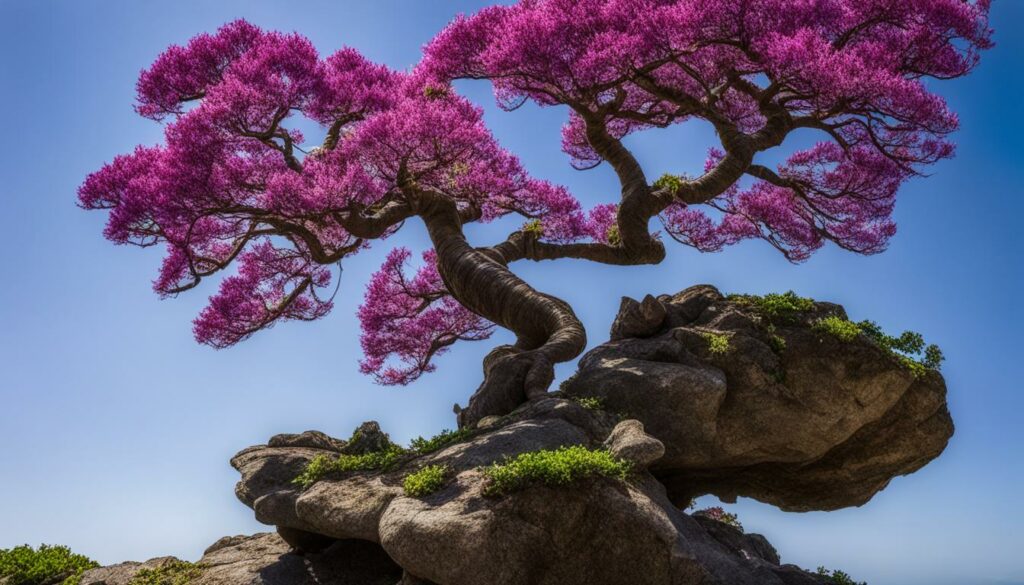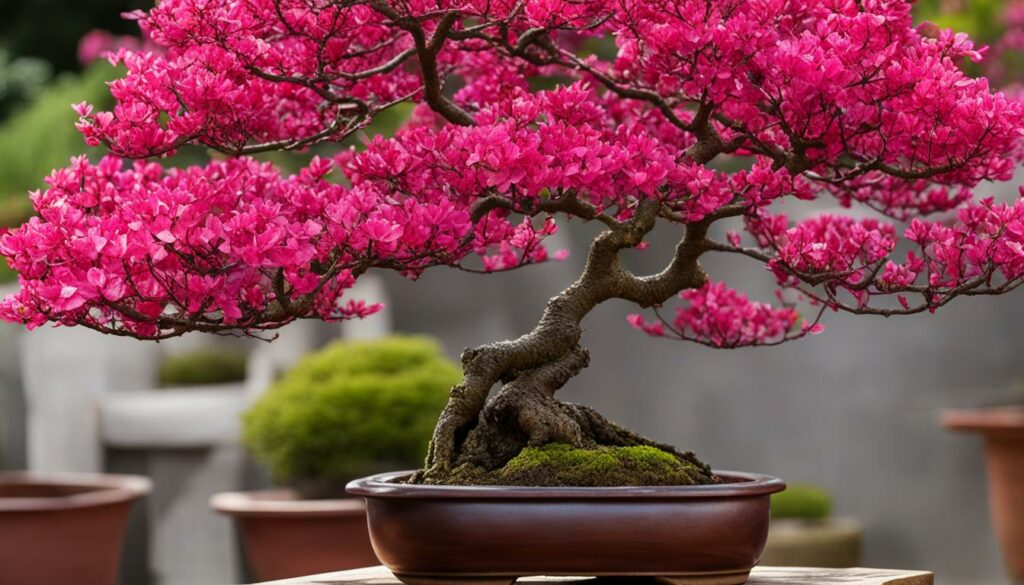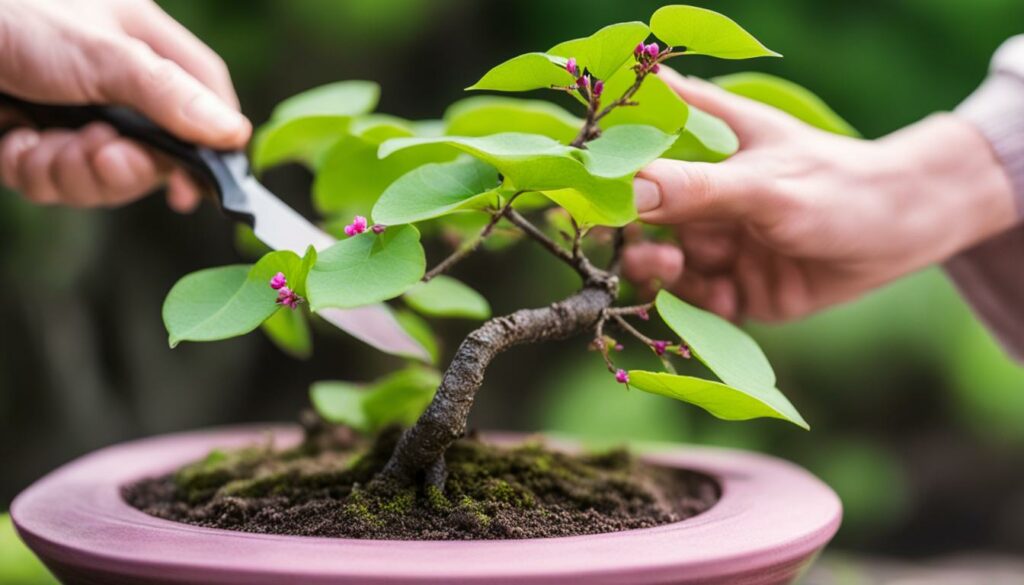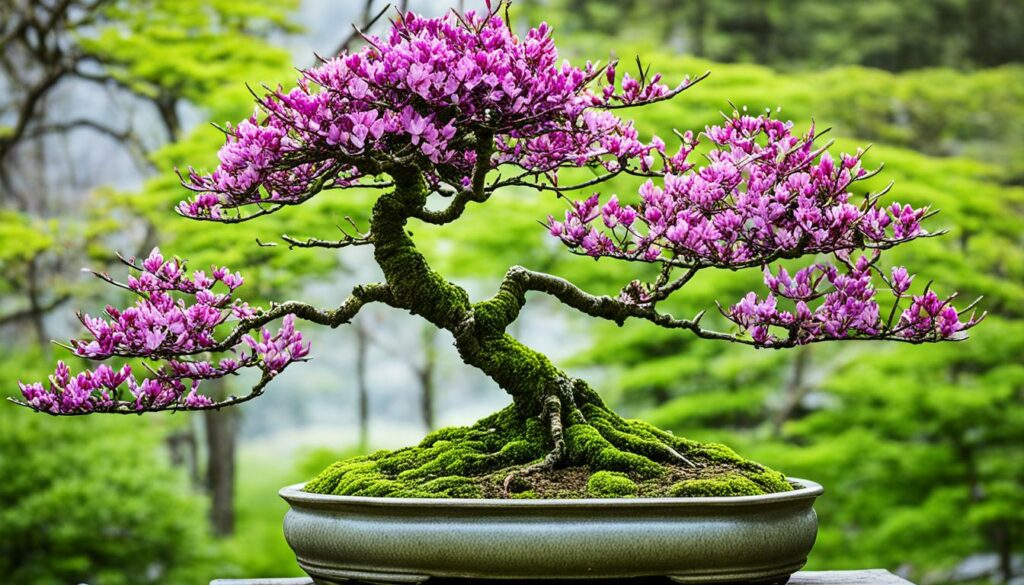Welcome to our exploration of the captivating world of Bonsai Tree Species Cercis, also known as Redbud bonsai. If you are a bonsai enthusiast, you will undoubtedly enjoy discovering the unique features and cultivation techniques of this enchanting deciduous bonsai tree.
The Cercis bonsai species is renowned for its charming pink or purple flowers that bloom in early spring, creating an exquisite natural spectacle. This delightful tree species hails from North America and is relatively easy to cultivate, making it a popular choice among bonsai hobbyists.
In this article, we will delve deeper into the characteristics and behavior of the Cercis bonsai tree species. We will also provide you with expert tips and guidance on cultivating and caring for your own Redbud bonsai tree. From beginner to advanced levels, this guide has you covered.
Key Takeaways:
- Bonsai Tree Species Cercis is also known as Redbud bonsai and is native to North America
- Cercis bonsai species blooms with gorgeous pink or purple flowers in early spring
- This deciduous bonsai species is relatively easy to cultivate and an ideal choice for bonsai enthusiasts of all levels
- In this article, we will provide you with expert tips on how to cultivate and care for your own Cercis bonsai tree
- Stay tuned for more information on understanding the characteristics and behavior of Cercis bonsai tree species in the next section
Understanding the Cercis Bonsai Tree Species
The Redbud bonsai, also known as Cercis bonsai, boasts unique traits that make it a favorite choice among bonsai enthusiasts. As a deciduous bonsai species, it sheds its leaves annually, giving a fresh start to every growing season.
During springtime, Redbud bonsai produce stunning magenta-colored flowers that instantly add charm and vibrancy to any space. This species’ lush foliage turns yellow in autumn, creating a spectacular display of colors.
Caring for a Cercis bonsai tree requires attention to detail and a deep understanding of its characteristics. This species thrives in full sun to partial shade and thrives in well-draining soil. Maintaining appropriate moisture levels in the soil is key, as this species prefers moderately moist roots.
As Redbud bonsai is susceptible to pests and diseases, regular inspections, and preventive measures are necessary to protect its health and beauty.

The Distinctive Traits of Redbud Bonsai
| Trait | Characteristic |
|---|---|
| Origin | Indigenous to Eastern North America and Mexico |
| Leaves | Heart-shaped leaves grow up to 3-5 inches long |
| Flowers | Blossom during April-May, producing pink to reddish-hued flowers |
| Fruits | Pod-shaped brown fruits, 2-4 inches long |
| Growth | Can reach up to 20-30 feet when grown in the ground but are kept small as bonsai trees |
Exploring the unique features of the Cercis bonsai tree species and nurturing its growth can be a rewarding experience for both seasoned and novice bonsai enthusiasts.
Cultivating Your Own Cercis Bonsai Tree
Redbud bonsai cultivation requires patience, attention to detail, and knowledge of the species to yield beautiful results. Consider the following tips to cultivate your own stunning Cercis bonsai:
- Begin with a healthy specimen – choose a young Redbud bonsai with firm, green leaves and a sturdy trunk. Avoid any trees with yellowing or damaged leaves, as it may indicate underlying health issues.
- Choose the right-sized pot – Redbud bonsai requires a pot with good drainage that is proportional to the size of the tree. Avoid pots too small that don’t provide adequate room for root growth, or too large that can retain too much moisture.
- Provide ample sunlight and water – Cercis bonsai requires plenty of sunlight to grow healthy leaves and maintain its desirable shape. Ensure to water your bonsai tree regularly to keep the soil evenly moist.
- Prune and shape your Redbud bonsai – Pruning is paramount for maintaining the beautiful shape and health of your Cercis bonsai. You will need to trim off dead leaves, twigs, and branches regularly to promote growth and visual appeal.
- Chose the proper soil mix – Redbud bonsai requires a soil mix with adequate drainage and the right balance of nutrients.
Remember that each Redbud bonsai has unique requirements and tendencies. Pay close attention to your tree’s development and adjust its care according to its current state to ensure a desirable outcome.
Pro Tip: To ensure that your bonsai thrives throughout the year, remember to inspect it regularly for signs of pests and diseases. Early detection can save your Cercis bonsai from damage that may result in permanent harm or even death.

A Comparison of Different Soil Mixes
| Soil Mix | Description | Pros | Cons |
|---|---|---|---|
| Standard Mix | A mix of Akadama, pumice, and lava rock with perlite and organic fertilizer | Accessible and affordable | May retain too much water and contain soil-borne diseases or pests |
| Kanuma Mix | A type of soil made from red volcanic ash, organic moss, and Japanese pine bark | Optimal acidity and moisture retention properties for Cercis bonsai | Expensive and difficult to find, may require additional supplementation |
| Gravel Mix | A mix of coarse sand, gravel, and peat moss | Good drainage and aeration with minimal risk of soil-borne diseases | May lack sufficient nutrients or moisture retention |
Choosing the right soil mix may impact the growth, appearance, and health of your Redbud bonsai. Consider your tree’s individual needs and the availability of soil mixes in your area when making your selection.
Maintaining the Beauty of Your Cercis Bonsai
After successfully cultivating your Cercis bonsai tree, it’s crucial to maintain its attractiveness and health.
Watering your Redbud bonsai
Proper watering is essential to ensure the survival and growth of your Redbud bonsai. Watering should be done regularly, ensuring that the soil is not allowed to dry out completely. During the summer, it should be watered daily, while in the winter, the frequency should be reduced to two or three times a week. To test if it needs watering, you can use a soil moisture meter or insert a wooden stick into the soil. If it comes out dry, the tree needs to be watered.
Fertilizing your Cercis bonsai
A well-fed Cercis bonsai tree will be more resistant to pests and diseases and will grow better. Fertilizing should be done during the growing season, between spring and autumn. Use a balanced, slow-release fertilizer and follow the instructions on the label. Be careful not to over-fertilize the tree, as this can burn the roots.
Preventing diseases and pests
Preventing diseases and pests is crucial for maintaining the health of your Redbud bonsai. Inspect the tree regularly for signs of problems such as leaf discoloration or deformation, sticky residue on the leaves, or unusual growths. If detected, treat the tree immediately with an appropriate insecticide or fungicide.
Enhancing the aesthetics of your tree
Wiring and shaping are techniques used to enhance the aesthetics of your Cercis bonsai. Wiring involves wrapping wire around the branches to bend and shape them into the desired form. Shaping involves pruning the tree to achieve the desired shape and improve the visual appeal. However, these techniques should be used carefully and sparingly, as excessive wiring or pruning can damage the tree.

“Cercis bonsai care is essential to maintain the health and beauty of your Redbud bonsai. Proper watering, fertilization, and disease prevention techniques are vital. When using wiring and shaping techniques, be careful and sparing to avoid damaging the tree.”
Conclusion
Congratulations on reaching the end of our exploration of Bonsai Tree Species Cercis, also known as Redbud bonsai. We hope this article has provided you with valuable insights and knowledge on how to cultivate and care for your own Cercis bonsai tree. Remember, the charm and beauty of this deciduous bonsai species are unparalleled, and it is an ideal choice for aficionados looking to create their oasis of tranquility and natural elegance.
By understanding the unique traits and behavior of Redbud bonsai and using the expert tips and guidance provided in this article, you can successfully cultivate, shape and maintain a stunning masterpiece of this bonsai species. Be sure to follow the proper cultivation and care practices, including watering, fertilization, pruning, wiring, and shaping, to ensure the longevity of your Cercis bonsai’s beauty.
Thank you for reading, and we hope you have enjoyed this journey through the captivating world of Bonsai Tree Species Cercis, the charming Redbud bonsai.
FAQ
What is Cercis bonsai?
Cercis bonsai is a bonsai tree species belonging to the Cercis genus. It is also commonly known as Redbud bonsai due to its vibrant pink or purple flowers that bloom in spring.
What are the unique features of Cercis bonsai?
Cercis bonsai is a deciduous bonsai tree species, meaning it sheds its leaves in the fall. It is known for its heart-shaped leaves and attractive flowers, which add a touch of elegance to any bonsai collection.
How do I care for Cercis bonsai throughout the year?
Caring for Cercis bonsai involves providing it with proper sunlight exposure, regular watering, and a well-draining soil mix. During the winter months, it is important to protect the bonsai from freezing temperatures and provide adequate moisture.
Can I grow my own Cercis bonsai tree?
Yes, you can cultivate your own Cercis bonsai tree. Starting with a young sapling or pre-bonsai specimen is recommended. Patience and proper techniques such as pruning, wiring, and shaping are essential for shaping your Redbud bonsai into a beautiful tree.
How do I maintain the health of my Cercis bonsai?
To maintain the health of your Cercis bonsai, it is crucial to monitor its watering requirements, provide appropriate fertilization, and regularly check for pests or diseases. Proper pruning and wiring techniques should also be employed to maintain the desired shape and structure of your bonsai tree.


